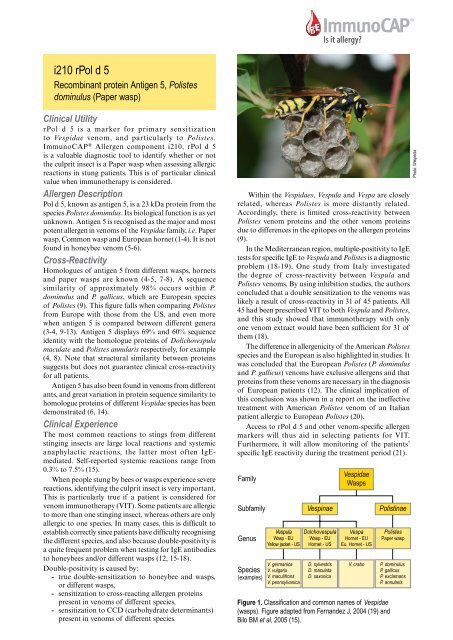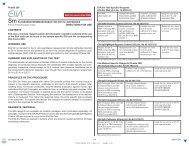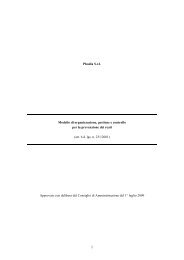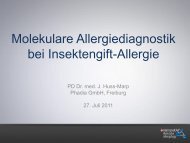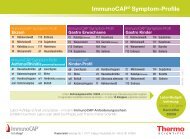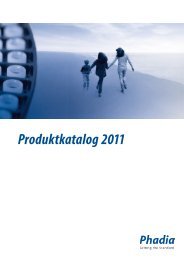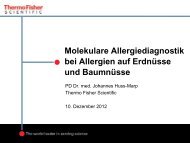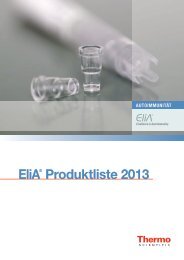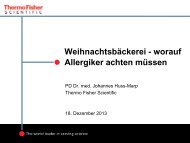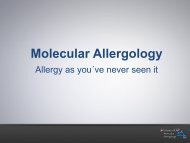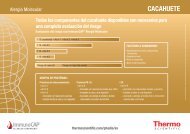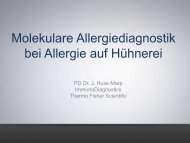You also want an ePaper? Increase the reach of your titles
YUMPU automatically turns print PDFs into web optimized ePapers that Google loves.
i210 rPol d 5<br />
Recombinant protein Antigen 5, Polistes<br />
dominulus (Paper wasp)<br />
Clinical Utility<br />
rPol d 5 is a marker for primary sensitization<br />
to Vespidae venom, and particularly to Polistes.<br />
ImmunoCAP ® Allergen component i210, rPol d 5<br />
is a valuable diagnostic tool to identify whether or not<br />
the culprit insect is a Paper wasp when assessing allergic<br />
reactions in stung patients. This is of particular clinical<br />
value when immunotherapy is considered.<br />
Allergen Description<br />
Pol d 5, known as antigen 5, is a 23 kDa protein from the<br />
species Polistes dominulus. Its biological function is as yet<br />
unknown. Antigen 5 is recognised as the major and most<br />
potent allergen in venoms of the Vespidae family, i.e. Paper<br />
wasp, Common wasp and European hornet (1-4). It is not<br />
found in honeybee venom (5-6).<br />
Cross-Reactivity<br />
Homologues of antigen 5 from different wasps, hornets<br />
and paper wasps are known (4-5, 7-8). A sequence<br />
similarity of approximately 98% occurs within P.<br />
dominulus and P. gallicus, which are European species<br />
of Polistes (9). This figure falls when comparing Polistes<br />
from Europe with those from the US, and even more<br />
when antigen 5 is compared between different genera<br />
(3-4, 9-13). Antigen 5 displays 69% and 60% sequence<br />
identity with the homologue proteins of Dolichovespula<br />
maculate and Polistes annularis respectively, for example<br />
(4, 8). Note that structural similarity between proteins<br />
suggests but does not guarantee clinical cross-reactivity<br />
for all patients.<br />
Antigen 5 has also been found in venoms from different<br />
ants, and great variation in protein sequence similarity to<br />
homologue proteins of different Vespidae species has been<br />
demonstrated (6, 14).<br />
Clinical Experience<br />
The most common reactions to stings from different<br />
stinging insects are large local reactions and systemic<br />
anaphylactic reactions, the latter most often IgEmediated.<br />
Self-reported systemic reactions range from<br />
0.3% to 7.5% (15).<br />
When people stung by bees or wasps experience severe<br />
reactions, identifying the culprit insect is very important.<br />
This is particularly true if a patient is considered for<br />
venom immunotherapy (VIT). Some patients are allergic<br />
to more than one stinging insect, whereas others are only<br />
allergic to one species. In many cases, this is difficult to<br />
establish correctly since patients have difficulty recognising<br />
the different species, and also because double-positivity is<br />
a quite frequent problem when testing for IgE antibodies<br />
to honeybees and/or different wasps (12, 15-18).<br />
Double-positivity is caused by:<br />
- true double-sensitization to honeybee and wasps,<br />
or different wasps,<br />
- sensitization to cross-reacting allergen proteins<br />
present in venoms of different species,<br />
- sensitization to CCD (carbohydrate determinants)<br />
present in venoms of different species.<br />
Within the Vespidaes, Vespula and Vespa are closely<br />
related, whereas Polistes is more distantly related.<br />
Accordingly, there is limited cross-reactivity between<br />
Polistes venom proteins and the other venom proteins<br />
due to differences in the epitopes on the allergen proteins<br />
(9).<br />
In the Mediterranean region, multiple-positivity to IgE<br />
tests for specific IgE to Vespula and Polistes is a diagnostic<br />
problem (18-19). One study from Italy investigated<br />
the degree of cross-reactivity between Vespula and<br />
Polistes venoms. By using inhibition studies, the authors<br />
concluded that a double sensitization to the venoms was<br />
likely a result of cross-reactivity in 31 of 45 patients. All<br />
45 had been prescribed VIT to both Vespula and Polistes,<br />
and this study showed that immunotherapy with only<br />
one venom extract would have been sufficient for 31 of<br />
them (18).<br />
The difference in allergenicity of the American Polistes<br />
species and the European is also highlighted in studies. It<br />
was concluded that the European Polistes (P. dominulus<br />
and P. gallicus) venoms have exclusive allergens and that<br />
proteins from these venoms are necessary in the diagnosis<br />
of European patients (12). The clinical implication of<br />
this conclusion was shown in a report on the ineffective<br />
treatment with American Polistes venom of an Italian<br />
patient allergic to European Polistes (20).<br />
Access to rPol d 5 and other venom-specific allergen<br />
markers will thus aid in selecting patients for VIT.<br />
Furthermore, it will allow monitoring of the patients’<br />
specific IgE reactivity during the treatment period (21).<br />
Family<br />
Subfamily<br />
Genus<br />
Species<br />
(examples)<br />
Vespula<br />
Wasp - EU<br />
Yellow jacket - US<br />
V. germanica<br />
V. vulgaris<br />
V. maculifrons<br />
V. pennsylvanica<br />
Vespinae<br />
Dolchovespula<br />
Wasp - EU<br />
Hornet - US<br />
D. sylvestris<br />
D. maculata<br />
D. saxonica<br />
Vespidae<br />
Wasps<br />
Vespa<br />
Hornet - EU<br />
Eu. Hornet - US<br />
Figure 1. Classification and common names of Vespidae<br />
(wasps). Figure adapted from Fernandez J, 2004 (19) and<br />
Bilo BM et al, 2005 (15).<br />
Polistinae<br />
Polistes<br />
Paper wasp<br />
V. crabo P. dominulus<br />
P. gallicus<br />
P. exclamans<br />
P. annularis<br />
Photo: Wikipedia
References<br />
1. Bohle B, Zwolfer B, Fischer GF, Seppala U, Kinaciyan T,<br />
Bolwig C, Spangfort MD, Ebner C.<br />
Characterization of the human T cell response to<br />
antigen 5 from Vespula vulgaris (Ves v 5).<br />
Clin Exp Allergy 2005;35(3):367-73.<br />
2. Hoffman DR.<br />
Allergens in Hymenoptera venom. V. Identification of<br />
some of the enzymes and demonstration of multiple<br />
allergens in yellow jacket venom.<br />
Ann Allergy 1978;40(3):171-6.<br />
3. Hoffman DR.<br />
Allergens in Hymenoptera venom XV: The<br />
immunologic basis of vespid venom cross-reactivity.<br />
J Allergy Clin Immunol 1985;75(5):611-3.<br />
4. Hoffman DR.<br />
Allergens in Hymenoptera venom. XXV: The amino<br />
acid sequences of antigen 5 molecules and the<br />
structural basis of antigenic cross-reactivity.<br />
J Allergy Clin Immunol 1993;92(5):707-16.<br />
5. Henriksen A, King TP, Mirza O, Monsalve RI, Meno K, Ipsen H,<br />
Larsen JN, Gajhede M, Spangfort MD.<br />
Major venom allergen of yellow jackets, Ves v 5:<br />
structural characterization of a pathogenesis-related<br />
protein superfamily.<br />
Proteins 2001;45(4):438-48.<br />
6. King TP, Guralnick M.<br />
Hymenoptera allergens, In Allergens and Allergen<br />
Immunotherapy.<br />
Lockey R, Bukantz S, Bousquet J, Eds. Marcel Dekker,<br />
New York 2004:339-54.<br />
7. Lu G, Villalba M, Coscia MR, Hoffman DR, King TP.<br />
Sequence analysis and antigenic cross-reactivity of a<br />
venom allergen, antigen 5, from hornets, wasps, and<br />
yellow jackets.<br />
J Immunol 1993;150(7):2823-30.<br />
8. Tomalski MD, King TP, Miller LK.<br />
Expression of hornet genes encoding venom allergen<br />
antigen 5 in insects.<br />
Arch Insect Biochem Physiol 1993;22(3-4):303-13.<br />
9. Pantera B, Hoffman DR, Carresi L, Cappugi G, Turillazzi S,<br />
Manao G, Severino M, Spadolini I, Orsomando G, Moneti G,<br />
Pazzagli L.<br />
Characterization of the major allergens purified from<br />
the venom of the paper wasp Polistes gallicus.<br />
Biochim Biophys Acta 2003;1623(2-3):72-81.<br />
10. Monteiro MC, Romão PR, Soares AM.<br />
Pharmacological perspectives of wasp venom.<br />
Protein Pept Lett 2009;16(8):944-52.<br />
11. King TP, Lu G, Gonzalez M, Qian N, Soldatova L.<br />
Yellow jacket venom allergens, hyaluronidase and<br />
phospholipase: sequence similarity and antigenic<br />
cross-reactivity with their hornet and wasp homologs<br />
and possible implications for clinical allergy.<br />
J Allergy Clin Immunol 1996;98(3):588-600.<br />
12. Severino MG, Campi P, Macchia D, Manfredi M, Turillazzi S,<br />
Spadolini I, Bilo MB, Bonifazi F.<br />
European Polistes venom allergy.<br />
Allergy 2006;61(7):860-3.<br />
13. Sanchez F, Blanca M, Fernandez J, Miranda A, Terrados A,<br />
Torres MJ, Del Cano A, Garcia JJ, Juarez C.<br />
Comparative study between European and American<br />
species of Polistes using sera from European sensitized<br />
subjects.<br />
Clin Exp Allergy 1995;25(3):281-7.<br />
14. Lee EK, Jeong KY, Lyu DP, Lee YW, Sohn JH, Lim KJ, Hong CS,<br />
Park JW.<br />
Characterization of the major allergens of<br />
Pachycondyla chinensis in ant sting anaphylaxis<br />
patients.<br />
Clin Exp Allergy 2009;39(4):602-7.<br />
15. Bilo BM, Rueff F, Mosbech H, Bonifazi F, Oude-Elberink JN.<br />
Diagnosis of Hymenoptera venom allergy.<br />
Allergy 2005;60(11):1339-49.<br />
16. Hemmer W, Focke M, Kolarich D, Wilson IB, Altmann F, Wöhrl S,<br />
Götz M, Jarisch R.<br />
Antibody binding to venom carbohydrates is a<br />
frequent cause for double positivity to honeybee and<br />
yellow jacket venom in patients with stinging-insect<br />
allergy.<br />
J Allergy Clin Immunol 2001;108(6):1045-52.<br />
See i209 Api m 1 product leeflet.<br />
17. Muller UR, Johansen N, Petersen AB, Fromberg-Nielsen J,<br />
Haeberli G.<br />
Hymenoptera venom allergy: analysis of double<br />
positivity to honey bee and Vespula venom by<br />
estimation of IgE antibodies to species-specific major<br />
allergens Api m 1 and Ves v 5.<br />
Allergy 2009;64(4):543-8.<br />
18. Caruso B, Bonadonna P, Severino MG, Manfredi M, Dama A,<br />
Schiappoli M, Rizzotti P, Senna G, Passalacqua G.<br />
Evaluation of the IgE cross-reactions among vespid<br />
venoms. A possible approach for the choice of<br />
immunotherapy.<br />
Allergy 2007 May;62(5):561-4.<br />
19. Fernandez J.<br />
Distribution of Vespid species in Europe.<br />
Curr Opinion Clin Immunol 2004;4:319-24.<br />
20. Bonadonna P, Caruso B, Labardi D, Dama A, Senna G,<br />
Passalacqua G.<br />
Treatment with American Polistes venom was<br />
ineffective in an Italian patient allergic to European<br />
Polistes.<br />
Allergy 2007;62(8):966-7.<br />
21. De Graaf DC, Aerts M, Danneels E, Devreese B.<br />
Bee, wasp and ant venomics pave the way for a<br />
component-resolved diagnosis of sting allergy.<br />
J Proteomics 2009;72(2):145-54.<br />
For further reading, see: www.immunocapinvitrosight.com<br />
<strong>Phadia</strong> AB. P O Box 6460, SE-751 37 Uppsala, Sweden<br />
Tel +46 18 16 50 00. www.phadia.com<br />
March 2010


